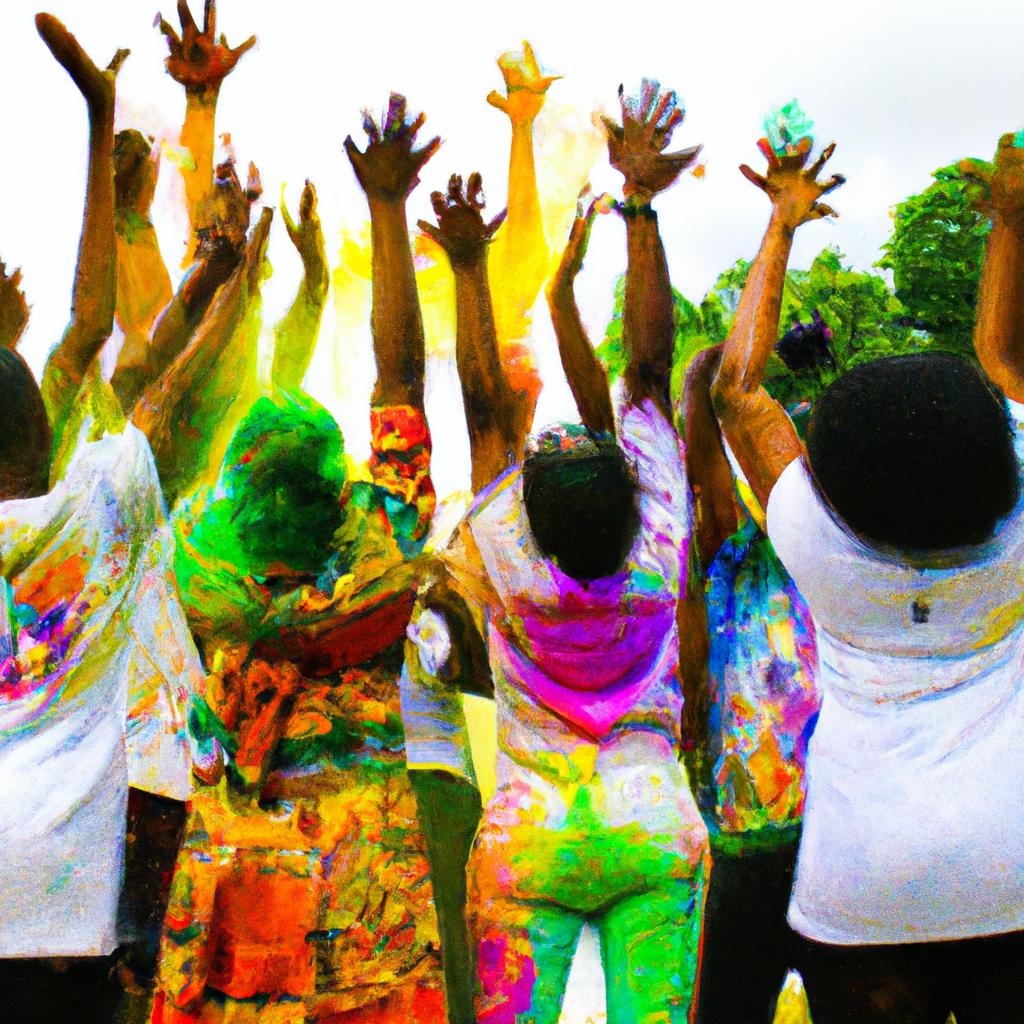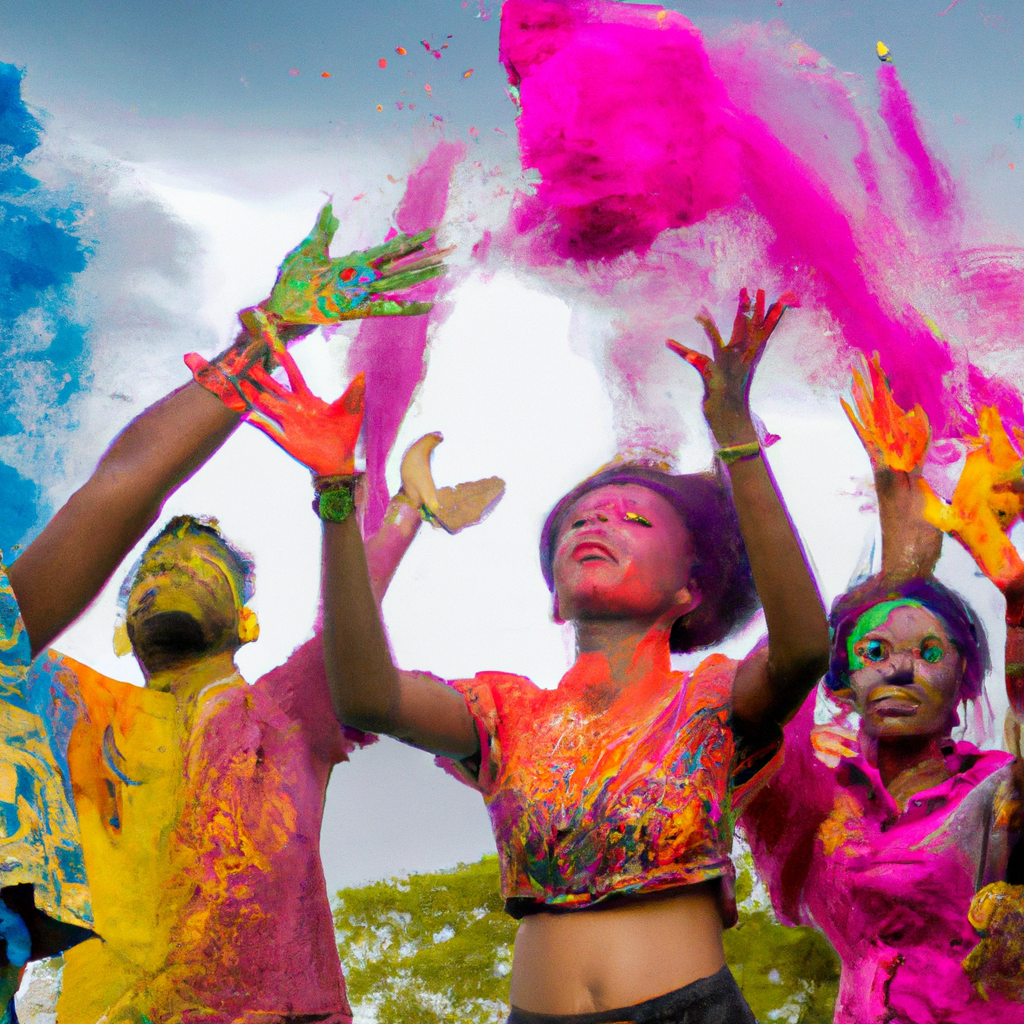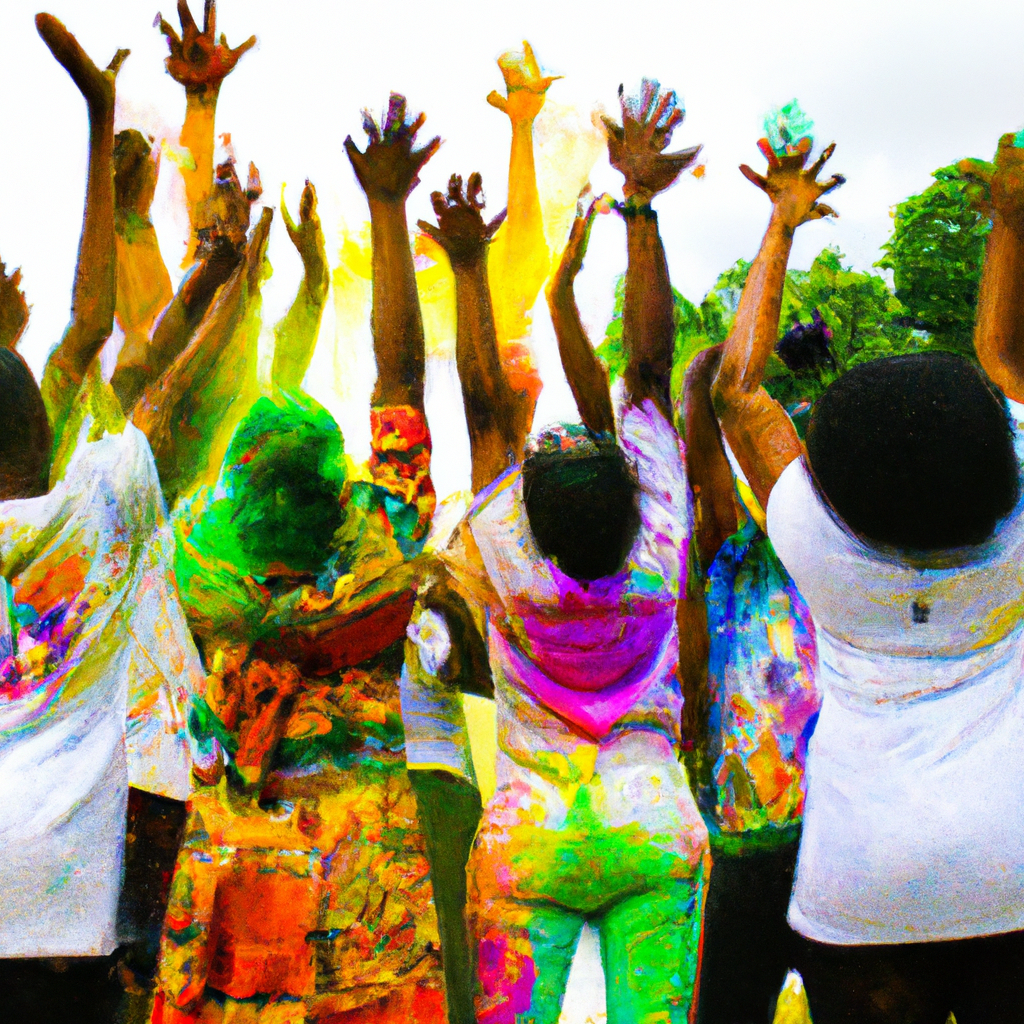Imagine yourself immersed in a vibrant explosion of colors. The air filled with laughter and joy as people dance, sing, and splash each other with brightly pigmented powders. This is the experience of celebrating Holi in Suriname, a small South American country where a fusion of cultures comes alive. Suriname, with its diverse population and rich history, has embraced Holi as a festival that unites its multicultural communities in a dazzling display of harmony and unity. As you delve into the intricate tapestry of Suriname’s traditions, you will discover the unique allure of Holi celebrated in this country like nowhere else in the world.
History of Holi in Suriname
Arrival of Indians in Suriname
The history of Holi in Suriname dates back to the arrival of Indian immigrants in the 19th century. These immigrants came to Suriname as indentured laborers, primarily from Bihar and Uttar Pradesh in India. They were brought to work on the plantations under the Dutch colonial rule. As they settled in Suriname, they carried with them their rich cultural traditions, including the festival of Holi.
How Holi came to be celebrated in Suriname
As the Indian community grew in Suriname, they sought ways to celebrate and preserve their cultural heritage. Holi, with its vibrant colors and joyful celebrations, became an integral part of their social and religious calendar. The festival served as a way to connect with their roots and maintain their religious identity in a foreign land.
Evolution of Holi celebrations in Suriname
Over the years, Holi celebrations in Suriname have evolved and adapted to the local culture. The festival has become more inclusive, with people from different backgrounds joining in the festivities. It has transformed into a vibrant and multicultural celebration that reflects the diversity and harmony of Surinamese society.
Significance of Holi
Hindu mythology and symbolism
Holi is rooted in Hindu mythology and has various symbolic meanings. It is primarily associated with the legend of Prahlada and Holika, which signifies the victory of good over evil. The festival also marks the arrival of spring and the triumph of colors, representing the joy and renewal of life.
Spiritual and cultural significance
Beyond its mythological roots, Holi holds spiritual and cultural significance for Hindus. It is a time for forgiveness, letting go of past grievances, and embracing new beginnings. The festival encourages people to come together, mend relationships, and foster unity and love in their communities.
Unifying the Surinamese society
Holi plays a vital role in unifying the Surinamese society by bringing people of different ethnicities and religions together. The festival transcends religious boundaries and becomes a platform for cultural exchange and mutual understanding. It promotes harmony, respect, and appreciation for diversity among Surinamese communities.

Traditional Holi Celebrations
Preparations and rituals
Holi preparations typically begin weeks in advance. People clean their homes, buy new clothes, and gather the necessary ingredients for the festivities. Special rituals and prayers are performed, and families come together to create rangoli designs and decorate their houses with vibrant colors.
Holika Dahan: The bonfire
The night before Holi, a bonfire known as Holika Dahan is lit. This ritual symbolizes the victory of good over evil and commemorates the story of Prahlada. People sing and dance around the fire, offering prayers and seeking blessings for happiness and prosperity.
Playing with colors: Abir and Gulal
The most iconic aspect of Holi is the playing with colors. On the day of the festival, people gather in public spaces, streets, and parks to drench each other in colored powders known as abir and gulal. This playful act symbolizes equality and the breaking down of social barriers.
Water play: Pichkaris and water balloons
Water also plays a significant role in Holi celebrations. People joyfully splash water on each other using pichkaris (water sprinklers) and throw water balloons. This adds an element of fun and excitement to the festivities, particularly in the tropical climate of Suriname.
Music, dance, and food
Music and dance are integral parts of Holi celebrations. Traditional instruments like the dholak and tassa drums are played, creating a lively and energetic atmosphere. People dance to the beats, singing traditional Sarnami songs and enjoying the cultural performances. Special festive dishes are prepared and shared, adding to the overall joyous atmosphere.
Influence of Surinamese Culture
Blend of Indian and Surinamese traditions
In Suriname, the celebration of Holi has been influenced by the local Surinamese culture. It has blended with Surinamese traditions, creating a unique fusion of Indian and Surinamese customs. This amalgamation is evident in the music, food, and overall atmosphere of Holi celebrations.
Music: Dholak, Tassa, and Sarnami songs
The music played during Holi in Suriname reflects the multicultural background of the country. Traditional Indian instruments like the dholak and tassa drums are played alongside Western instruments, creating a distinct Surinamese sound. Sarnami songs, which are sung in a mix of Bhojpuri and Dutch, add another layer of cultural richness to the festivities.
Fusion of Surinamese and Indian cuisine
The culinary aspect of Holi celebrations in Suriname showcases the blending of Surinamese and Indian cuisines. Traditional Indian sweets like gujiya and jalebi are prepared alongside Surinamese delicacies like roti and bara. This fusion of flavors represents the harmonious coexistence of different culinary traditions.
Multicultural participation
One of the standout features of Holi celebrations in Suriname is the participation of people from various cultural backgrounds. Surinamese of different ethnicities, including Creoles, Javanese, Chinese, and Maroons, actively engage in the festivities. This multicultural participation highlights the inclusive and diverse nature of Surinamese society.

Holi Events and Celebrations
Public Holi festivals in Suriname
Suriname hosts several large-scale public Holi festivals that attract both locals and tourists. These events are organized in parks and open spaces, providing a platform for people to come together and celebrate Holi in a vibrant and festive atmosphere. Live music, dance performances, and cultural shows entertain the attendees.
Community gatherings and temple celebrations
In addition to public events, Holi is also celebrated within various communities and temples across Suriname. These intimate gatherings allow for deeper connections and a more traditional expression of the festival. People engage in prayers, cultural rituals, and share traditional meals, reinforcing the sense of community within their respective groups.
Holi-themed parties and cultural shows
Holi-themed parties and cultural shows have gained popularity in Suriname in recent years. These events often take place in hotels, clubs, or cultural centers and cater to diverse audiences. They feature live performances, DJs playing both Indian and Surinamese music, and additional entertainment elements like dance-offs and fashion shows.
Color runs and other unique events
Suriname has also embraced unique variations of Holi, such as color runs and charity events. Color runs involve participants running or walking a designated route while getting splashed with colored powders. These events promote fitness, fun, and community engagement, attracting people of all ages and backgrounds.
Holi Tourism in Suriname
Growing popularity among tourists
Holi celebrations in Suriname have gained significant popularity among tourists in recent years. Visitors are drawn to the vibrant and multicultural nature of the festival, which offers a unique cultural experience. Suriname’s rich history, diverse population, and welcoming hospitality make it an ideal destination for those seeking an immersive Holi celebration.
Tourist attractions during Holi
Suriname offers a range of tourist attractions that can be explored alongside Holi celebrations. The capital city, Paramaribo, boasts a UNESCO World Heritage-listed historic center, where visitors can admire colonial architecture and visit local markets. The country’s vast rainforests, scenic rivers, and exotic wildlife provide opportunities for eco-tourism and adventure activities.
Cultural tours and heritage experiences
For tourists interested in immersing themselves in Surinamese culture, various cultural tours and heritage experiences are available. These include visits to traditional villages, museums, and art galleries showcasing Surinamese history, art, and crafts. The Holi festivities serve as a backdrop to these cultural explorations, enhancing the overall experience.
Accommodation and travel tips
Suriname offers a range of accommodations to suit different budgets and preferences. From luxury hotels in Paramaribo to eco-lodges in the jungle, visitors can find suitable options based on their requirements. When traveling to Suriname during Holi, it is advisable to book accommodations and flights in advance, as the festival attracts a significant number of visitors.
Harmony and Unity Through Holi
Promoting cultural understanding and tolerance
Holi plays a vital role in promoting cultural understanding and tolerance in Suriname. The festival brings people from diverse backgrounds together, fostering greater empathy and respect for different cultures and religions. It encourages dialogue, exchange, and appreciation, thereby contributing to the creation of a more harmonious and inclusive society.
Fostering unity in diversity
Suriname is known for its multiculturalism, and Holi serves as a powerful symbol of unity in diversity. The festival serves as a reminder that despite individual differences, people can come together to celebrate, share, and embrace each other’s traditions. It strengthens the bonds between communities, deepens social connections, and enhances the sense of belonging within Surinamese society.
Impact on social integration and national identity
Holi’s celebration in Suriname has significant implications for social integration and national identity. By actively participating in Holi festivities, people from different ethnicities and cultural backgrounds feel a sense of belonging to Surinamese society. The shared experience of celebrating Holi strengthens the collective identity and reinforces Surinamese national unity.
Preservation of Surinamese Traditions
Efforts to maintain cultural heritage
Surinamese culture and traditions, including Holi, are treasured and actively preserved within the community. Various organizations, temples, and cultural associations organize events, workshops, and initiatives to promote and safeguard these traditions. These efforts ensure that Holi continues to be celebrated in its authentic form and serves as a source of cultural pride for Surinamese people.
Role of Holi in preserving traditions
Holi plays a significant role in preserving Surinamese traditions by providing a platform for cultural expression and transmission. It serves as a vehicle for passing down customs, rituals, and stories from one generation to another. Through Holi, Surinamese traditions are not only retained but also shared with others, ensuring their continuity and relevance.
Challenges and future prospects
The preservation of Surinamese traditions, including Holi, does face certain challenges. As younger generations become more exposed to global influences, there is a risk of dilution or loss of cultural practices. However, the enthusiasm and dedication of community members, combined with increasing awareness and support from the government, provide hope for the preservation and promotion of Surinamese traditions in the future.
Holi in the Global Context
Spread of Holi celebrations worldwide
Holi has transcended boundaries and gained recognition as a global festival. Indian diaspora communities have taken Holi celebrations to countries around the world, sharing the joy and cultural significance of the festival. Suriname’s unique celebration of Holi has contributed to this global spread and continues to inspire similar festivities in diverse locations.
Suriname’s unique contribution to global Holi
Suriname’s celebration of Holi stands out due to its fusion of Indian and Surinamese cultural elements. The blending of traditions, music, and cuisine has added a distinct flavor to the global Holi landscape. Surinamese Holi celebrations have become an inspiration for others, showcasing the beauty of cultural diversity and fostering intercultural exchange worldwide.
Cultural exchange and cross-cultural interactions
Holi celebrations in Suriname facilitate cultural exchange and cross-cultural interactions on an international scale. Tourists and visitors from different countries come together to partake in the festivities, connect with the local community, and learn about Surinamese culture. This exchange of ideas and experiences contributes to greater cultural understanding and promotes global harmony.
Conclusion
The celebration of Holi in Suriname exemplifies the harmonious blend of cultures and the power of festivals to unite diverse communities. From its humble beginnings with the arrival of Indian immigrants, Holi has evolved into a multicultural extravaganza that embodies the spirit of Surinamese society. The festival’s significance goes beyond religious boundaries, serving as a platform for the preservation of traditions, the promotion of cultural understanding, and the celebration of diversity. Suriname’s unique contribution to the global Holi landscape highlights the country’s rich multicultural heritage and its commitment to fostering intercultural harmony. By celebrating diversity through Holi, Suriname showcases the beauty of cultural fusion while promoting a sense of unity and pride among its people.
